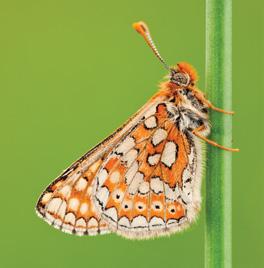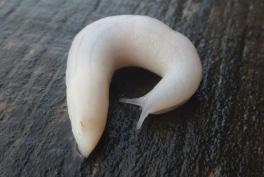
8 minute read
across the UK
NATIONAL UK News
A bottlenose dolphin leaps clear of the water in the Moray Firth
Advertisement
UK UPDATE A Big Splash For UK Seas - Our 2019 Marine Review
© John MacPherson/2020VISION
Together, the Wildlife Trusts form the UK’s largest marine conservation organisation. Our Living Seas teams are the eyes and ears of the UK’s coast. Throughout 2019, with the help of over 5,000 volunteers, they did wonderful things for the wildlife in our seas. Careful monitoring revealed some fantastic good news stories around our shores, from bumper breeding seasons to amazing discoveries. A new citizen science project logged 320 sightings of cetaceans off Yorkshire’s east coast, including minke whales, bottlenose dolphins and harbor porpoises. There was good news for seals too, with Cumbria Wildlife Trust counting a site record of 483 grey seals at South Walney, including seven pups. Elsewhere, an individual seal, nicknamed Tulip Belle, was discovered commuting between the Isle of Man and Cornwall. Lara Howe, Manx Wildlife Trust’s marine officer, says: “It shows that seals will swim great distances for food and a place to pup, highlighting the importance of a network of Marine Protected Areas around the UK, so that wherever marine wildlife goes there are healthy seas to support them.” Our fight to secure this network saw a huge victory last summer, with the designation of 41 new Marine Conservation Zones. 2019 also saw a welcome boost for some of our struggling seabirds. On Handa Island, Scottish Wildlife Trust counted 8,207 razorbills, the highest number since 2006, though the population is sadly still in trouble. In North Wales, Sandwich terns had a bumper year, with 800 chicks fledging compared to just 180 in 2018. Sadly, it wasn’t all good news. Several Wildlife Trusts reported an increase in disturbance. Jet skis, kayakers, boats and drones have all been recorded causing distress to marine wildlife like dolphins, seals and seabirds. Plastics, ocean litter and discarded fishing gear also continue to devastate marine wildlife, though Wildlife Trusts around our shores cleared up huge amounts of litter, including 2.5 tonnes picked up by the Isles of Scilly Wildlife Trust. All of this was made possible by the fantastic support of all our volunteers and members. For more amazing stories head to wildlifetrusts.org/marine-review-19
2019 IN NUMBERS
• Over 5,000 volunteers supported coastal Wildlife Trusts with beach cleans, surveys and shore-based events.
• More than 200 sharks, skates and rays were tagged as part of Ulster Wildlife’s SeaDeep project, helping us monitor these vulnerable animals.
• Two giant gobies were among 1,310 species recorded in just 24 hours as Devon Wildlife Trust’s Wembury Marine Centre celebrated its 25th anniversary.
• 27 tonnes of litter and fishing gear collected by fisherman for Yorkshire Wildlife Trust’s Fishing 4 Litter.
Get involved We need to put nature into recovery on land and at sea. Join us on our campaign for a wilder future: wildlifetrusts.org/wilder-future
Space for nature should be at the heart of our planning and farming systems. This is the only way we can create a Nature Recovery Network, enabling wildlife to thrive across the landscape and bringing nature into our daily lives. 100 Miles Wilder UK UPDATE
But current proposals for developing the land between Oxford and Cambridge do not have nature at their heart. Without proper assessment, government cannot know whether the area
© Tom Marshall could support the current proposals for housing, road and rail and stay within environmental limits for nature, carbon and water. Special habitats are under threat, including ancient woodland and grazing marsh, which supports rare and declining wading birds like curlew and redshank. The Wildlife Trusts have created an alternative vision for this land: 100 miles of wilder landscape in which people can live, work and enjoy nature. By protecting and connecting the wildest places, we can introduce a new way of planning that has nature and people’s wellbeing at the centre. Find out more wildlifetrusts.org/100-miles-wilder
The Wildlife Trusts are delighted to welcome Craig Bennett as their new Chief Executive Officer. One of the UK’s leading environmental campaigners, Craig joins The Wildlife Trusts from Friends of the Earth, where he was Chief Executive. In a conservation career spanning over 20 years, Craig has led a movement to end peat cutting on important moorlands, helped secure better wildlife legislation through The Countryside and Rights of Way Act 2000 and, more recently, led successful campaigns to highlight climate change and to protect and restore bee populations. New Leader For The Wildlife Trusts

Craig Bennett says: “The Wildlife Trusts are an extraordinary grassroots movement that is uniquely placed to work with local communities to make this happen and ensure a wilder future, and I could not be more pleased to have been asked to lead them at this incredibly important moment.” wildlifetrusts.org/new-leader
An Insect Apocalypse
A new report, Insect Declines and Why They Matter, commissioned by an alliance of Wildlife Trusts in the south west, concluded that drastic declines in insect numbers look set to have far-reaching consequences for both wildlife and people. The report concludes: “if insect declines are not halted, terrestrial and freshwater ecosystems will collapse, with profound consequences for human wellbeing.” wildlifetrusts.org/urgent-action-insects

© Ross Hoddinott/2020VISION
UK HIGHLIGHTS
Discover how The Wildlife Trusts are working for you across the UK.
Inspirational Youth Over the last year, over 2,800 young people aged 11-25 rolled up their sleeves to help nature thrive in their local area. The Grassroots Challenge project, led by Ulster Wildlife, gave young people the opportunity to unleash their passion, creativity and potential to make a real difference to their environment and community. ulsterwildlife.org/news/inspirational-youth 1
Attenborough Appeal Nottinghamshire Wildlife Trust launched an appeal to raise £1 million to safeguard Attenborough Nature Reserve, a wild oasis at the edge of Nottingham that’s home to large numbers of wildfowl. The appeal was supported by Sir David Attenborough and raised over £900,000 in the first month. nottinghamshirewildlife.org/lifelineappeal 2
Spooky Sighting A ghost slug was discovered in the gardens of Devon Wildlife Trust’s Cricklepit Mill. The origins of this mysterious species are uncertain, but it’s thought to be a native of Ukraine. Since ghost slugs were first discovered in the UK in 2007, there have been a scattering of sightings, mainly from South Wales. It’s a predator of earthworms and may cause problems for our native worms if it becomes established. devonwildlifetrust.org/news/ghost 3

by Joanna Richards © Illustration: Hilliard Design NATIONAL Natural Carbon Solutions
Peatland
Peatlands cover just 3% of the earth’s surface, but store more carbon than any other habitat on land (more than twice the carbon of all the world’s forests put together). But when damaged, as in the UK, they release carbon, contributing to climate change – so restoration is essential.
Urban greenspaces help make cities better in a world that’s getting hotter. Young street trees take up carbon dioxide and urban woodlands help control the local climate by providing shade and reducing the street temperature. Pleasant greenspaces can also encourage people to walk and cycle rather than jump in a car! Urban
As they grow, trees absorb carbon from the atmosphere, storing it in their trunk, boughs and roots and as organic matter in woodland soils. So, new woodland creation – through natural regeneration for example – helps to combat climate change.
These aquatic flowering plants are responsible for around 10% of all carbon buried in the ocean, despite covering less than 0.2% of the ocean floor. They store carbon 35 times faster that rainforests, but estimates suggest that globally we are losing an area of seagrass the size of two football pitches every hour. Like peatlands and grasslands, intertidal saltmarsh provides an important carbon store in its soils. Saltmarshes also act as a buer against coastal erosion – although this and rising sea levels is leading to the loss of this habitat, with only 15% of its historic range remaining. Seagrass Meadows Saltmarsh Woodland We face a climate emergency. Extreme weather events are on the increase and the impacts of a warming climate are becoming evident on our beloved wildlife, with some UK species being pushed to the furthest limits of their natural ranges. To tackle a crisis of this scale, it is imperative every tool in the box is used, and this includes the natural solutions offered by our planet. Over half of all carbon emissions released into the atmosphere by humans are re-absorbed by the Earth’s natural systems. And yet, many of these systems are broken, the habitats providing them damaged and degraded. Restoring these systems would allow even more carbon to be absorbed – and The Wildlife Trusts are playing a leading role in helping this happen. At sea, the Trusts fought for the Marine Act 2009: properly implemented it restores our most important carbon absorber and the wildlife that lives within it, including kelp and phytoplankton. On land, 9% of the UK’s surface is a huge carbon store with carbon locked up in wet peat. Carbon is also stored in organic rich soils, especially those under grasslands and woodlands. For decades, The Wildlife Trusts have pioneered peatland restoration and sustainably managed woodlands and grassland meadows. This work continues, thanks to our supporters, helping in the fight against climate change. Healthy grassland soaks up and stores carbon in its roots and the soil. Grasslands that are undisturbed by arable agriculture and protected from soil erosion through sustainable management are important stores. Yet in the UK, we’ve lost 97% of our semi-natural grassland and they continue to be at risk. Grassland
Marine Sediments
Phytoplankton – miniscule marine algae – absorb carbon as they grow. When they die, some of the carbon they’ve taken up sinks to the ocean floor, where it can remain for thousands of years.
Seaweed And Kelp Forests
Kelp grows incredibly quickly, sucking up carbon as it does. These underwater forests provide critical short-term carbon stores. When they die, bits of kelp sink into the deep sea, where they remain for a long time.
#30DaysWild A r e yo u r e a d y f o r #30DaysWild ? 1 – 30 June
Can you do something wild every day for 30 days? Nature needs us more than ever… so take the challenge and share your love of wildlife this June.


